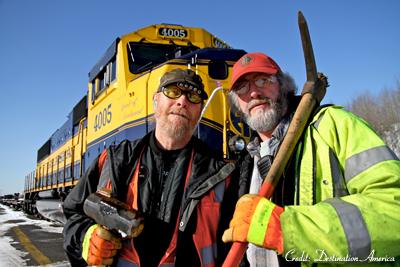
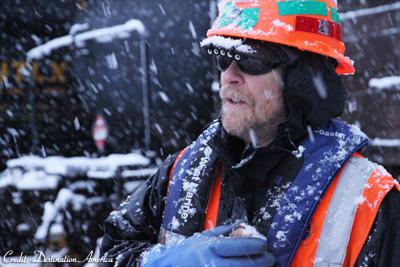
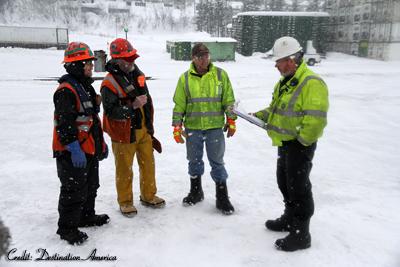
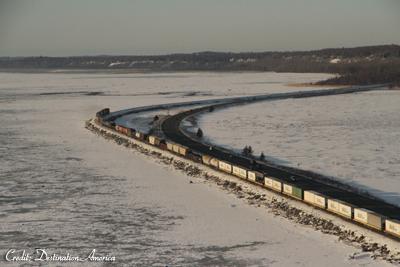
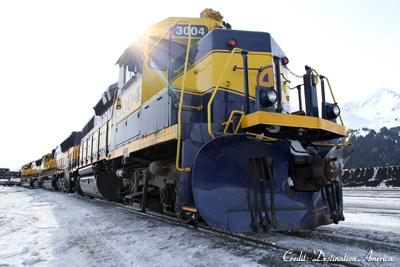
Following an elite crew of workers-- brakemen, engineers, construction crews, mechanics and train drivers – RAILROAD ALASKA illustrates the battle against ferocious weather and treacherous terrain to keep the State of Alaska’s critical 500-mile long railroad rolling to deliver life sustaining supplies. From controlled avalanches to prevent catastrophe, to fascinating characters, like Jim James, the one-handed handy man, learn what it takes to keep this train on track. Railroad Alaska premiered November 16, 2013 on Destination America on the Discovery Channel.
It was comprised of two seasons:
Season 1
- Frozen Danger
- The Beast
- Killer Ice
- Disaster Trail
- Ice Danger
- Spring Attacks
Season 2
- Bear Attack
- Mountain Danger
- Collision Course
- Avalanche Danger
- The Big Danger
- Ice Hell
- A Bridge Too Far
- Earthquake
- Ice Attack
- Train From Hell
On February 14, 2012 I was contacted by Development Producer Christian Broadhurst from Windfall Films. He was beginning development of a new documentary series on various aspects of the Alaskan Railroad and wanted to know if I would consider assisting. Of course I would! So for the past year and a half I have helped Christian with numerous tasks/requests in helping to bring the project to fruition. I must admit it was extremely exciting to watch (from my computer in Dayton, Ohio) the project grow into a full blown six episode series that would eventually air on the Discovery Channel! Recently, I gained permission to interview Craig Blackhurst the Series Producer at Windfall Films.
John Combs: When and where will this production be shown?
Craig Blackhurst: The series is to be broadcast on 16th November on Destination America.
JC: Tell me a bit about the development process.
CB: Development Producer Christian Broadhurst was tasked with contacting the Railroad back in early 2012. Tim Sullivan (MGR, External Affairs) then put the idea of making an observational TV series to (CEO) Chris Aadnesen. Apparently Chris liked some of the other documentaries that Windfall Films made and thought it might be a good idea. With access secured the hard work then started.
Series Producer Craig Blackhurst met various managers and they worked out a way that the film crew could work together with the Railroad and who should feature - i.e. MOW/ Engineers/ Conductors etc. Windfall Films also wanted to meet as many customers as we could (freight and passenger) and we developed the idea of incorporating the homesteaders that flag the train down up near Talkeetna.
JC:
What did you learn from this project? Both the positives and negatives.
CB: The first thing we learned was how to work with the various Railroad Crews that we filmed in a safe manner. Before we filmed anything we were all given an extensive briefing by Mark Mitchell (Director of Safety) and Dan Frerich (Chief Special Agent). It was made very clear that safety was the Railroad's number one priority. As well as working around heavy machinery that could kill us, we prepared for the bad weather and wildlife. We even brought along a former SAS soldier who specializes in cold weather survival to help get the film crew ready.
We had a good idea about how the Railroad operated, but our learning was accelerated everyday we filmed alongside them. For example everyone talks in abbreviations. "Go take the Hi rail, EX and BR up to 71." We obviously now know what that means (Drive up to slide zone 71 on the tracks and take the Excavator and Ballast Regulator) but the first time we heard that type of thing it was like a foreign language.
There were moments that we had been told would happen, but actually seeing them gave us a bigger appreciation of what the MOW crews face on a daily basis. The Avalanche mitigation work was awesome. When Roadmaster Bruce Gough and his crew wheeled out a 105 Korean war era howitzer and fired artillery shells at the Chugach Mountains that was a real eye opener. The avalanche caused was massive and really did highlight the dangers involved in running the Alaska Railroad.
JC: What obstacles did you need to overcome during filming?
CB: Most of the issues we faced involved the camera equipment we use. Sub zero temperatures mess with electronics. The biggest problems involved camera lenses and batteries. We attached mini cameras to the locomotives (freight and passenger) and found they would literally die within moments of leaving Whittier/ Seward/ Anchorage. Our tech specialist Colin Bowes worked closely with Steve Cain and others to find ways to power these small cameras and make them last a whole journey. When you watch the series you will see a lot of interesting photography and that's down to their determination.
JC: What assistance did you receive from the Alaska Railroad?
CB: Put simply - without their help and knowledge we wouldn't have been able to make this series. From their point of view it is was important that we illustrated the unique role played by the Railroad in the continual development of the State. It must be said that David Greenhalgh was instrumental in bringing everyone together and ensuring we were all on the same page. They also helped us check facts and make sure we didn't make any mistakes.
JC: What assistance did you receive from Alaskans?
CB: Alaskans are always straight talking and helpful. The advice we received and the back up we were given was really appreciated. We all now own a pair of Bunny Boots - something none of us Brits had heard of before filming started.
A special mention must also be made about the community in Talkeetna and the offgridders who rely on the Railroad. They are used to a quiet life during the winter, but made us feel like we had lived amongst them for years.
JC:
What do you hope will be the audience's chief takeaway from your series?
CB: Hopefully the audience will watch the series in wonderment. Alaska is one of the most beautiful States in America with an abundance of wildlife and the Railroad passes right through it. In the winter it can be one of the toughest environments to endure and I think it is a triumph of human endeavour that the Railroad brings together and supplies so many people... It's literally a Lifeline. If people understand why that is then I think we have done a good job.
JC: Is there any possibility of a follow-on to this series?
CB: That will depend on the Railroad and how many people watch and enjoy this series on Destination America - so get watching!
As a final note, your website has been a constant source of information and helped us throughout the edit process.
Click here for the Destination America: Railroad Alaska Conference Tape (pre-production mockup)
Click here to view Mark Payton's Flickr page showing the film crew on location